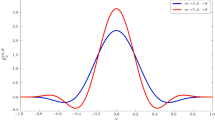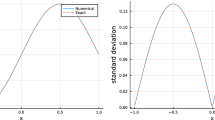Abstract
Accurate shock modeling requires that two critical issues be addressed: (1) correct representation of the essential shock physics, and (2) control of Gibbs phenomenon oscillation at the discontinuity. In this work a stable (oscillation limiting) and flux-conserved formulation under the reproducing kernel particle method is developed for shock modeling. A smoothed flux divergence is constructed under the framework of stabilized conforming nodal integration, which is locally-enriched with a Riemann solution to satisfy the entropy production constraints. This Riemann-enriched flux divergence is embedded into the reproducing kernel formulation through a velocity correction that also provides oscillation control at the shock. The correction is constrained to the shock region by an automatic shock detection algorithm that is constructed using the intrinsic spectral decomposition feature of the reproducing kernel approximation. Several numerical examples are provided to verify accuracy of the proposed formulation.


















Similar content being viewed by others
References
Leveque RJ (1992) Numerical methods for conservation laws. Birkhauser, Basel
Jeffrey A, Tanuiti T (1964) Mathematics in science and engineering. In: Bellman R (ed) Non-linear wave propagation: application to physics and magnetohydrodynamics. Academic Press, New York
Lax P (1957) Hyperbolic systems of conservation equations, II. Commun Pure Appl Math 10:537–566
Oleinik OA (1957) Discontinuous solutions of nonlinear differential equations. Uspeki Mat Nauk 12:3–73 (Am. Math. Soc. Translat. Ser. 2 26:95–172)
Osher S, Chakravarthy S (1984) High resolution schemes and the entropy condition. SIAM J Numer Anal 21(5):955–984
Godunov SK (1959) Finite-difference method for numerical computation of discontinuous solutions of the equations of fluid dynamics. Math Sbornik 47:271–306 (translated U.S. Joint Publ. Rel. Service, JPRS 7226)
Roe PL (1980) The use of the Riemann problem in finite-difference schemes. Lecture notes in physics, vol 141. Springer, New York, pp 354–359
Roe PL (1981) Approximate Riemann solvers, parameter vectors and difference schemes. J Comput Phys 43:357–372
Harten A, Hyman JM (1983) Self-adjusting grid methods for one-dimensional hyperbolic conservation laws. J Comput Phys 50:235–269
Osher S (1984) Riemann solvers, the entropy condition and difference approximations. SIAM J Numer Anal 21(5):955–984
van Leer B (1984) On the relation between the upwind difference schemes of Godunov. Engquist-Osher, and Roe. SIAM J Sci Stat Comput 5:1–20
VonNeumann J, Richtmyer RD (1950) A method for the numerical calculation of hydrodynamic shocks. J Appl Phys 21:232–237
Landshoff R (1955) A numerical method for treating fluid flow in the presence of shocks. Los Alamos Scientific Laboratory Report LA-1930
Wilkins ML (1980) Use of artificial viscosity in multidimensional fluid dynamics calculations. J Comput Phys 36:281–303
van Leer B (1974) Towards the ultimate conservative difference scheme, II. Monotonicity and conservation combined in a second-order accurate scheme. J Comput Phys 14:361–370
van Leer B (1979) Towards the ultimate conservative difference scheme, V: a second-order sequel to Godunov’s method. J Comput Phys 32:101–136
van Aldaba GD, van Leer B, Roberts WW (1982) A comparative study of computational methods in cosmic gas dynamics. Astron Astrophys 108:76–84
Roe PL (1986) Characteristic-based schemes for the Euler equations. Annu Rev Fluid Mech 18:337–365
Harten A, Osher S (1987) Uniformly high-order accurate nonoscillatory schemes. I. SIAM J Numer Anal 24(2):279–309
Harten A, Enquist B, Osher S, Chakravarty SR (1997) Uniformly high order accurate essentially non-oscillatory schemes, III. J Comput Phys 131:3–47
Liu X, Osher S, Chant T (1994) Weighted essentially non-oscillatory schemes. J Comput Phys 115:200–212
Christie I, Griffiths DF, Mitchell AR, Zienkiewicz OC (1976) Finite element methods for second order differential equations with significant first derivatives. Int J Numer Methods Eng 10:1389–1396
Kelly DW, Nakazawa S, Zienkiewicz OC, Heinrich JC (1980) A note on upwinding and anisotropic balancing dissipation in finite element approximations to convective diffusion problems. Int J Numer Methods Eng 15:1705–1711
Brooks AN, Hughes TJR (1982) Streamline upwind/Petrov-Galerkin formulations for convection dominated flows with particular emphasis on the incompressible Navier-Stokes equations. Comput Methods Appl Mech Eng 32:199–259
Hughes TJR, Brooks AN (1982) A theoretical framework for Petrov–Galerkin methods with discontinuous weight functions: applications to the streamline upwind procedure. In: Gallagher RH, Norrie DH, Oden JT, Zienkiewicz OC (eds) Finite elements in fluids, vol IV. Wiley, London, pp 46–65
Hughes TJR, Brooks AN (1979) A multidimensional upwind scheme with no crosswind diffusion. In: Hughes TJR (ed) Finite element methods for convection dominated flows, AMD 34. ASME, New York
Cockburn B, Shu CW (1989) TVB Runge–Kutta local projection discontinuous Galerkin finite element method for conservation laws II: general framework. Math Comput 52(186):411–435
Qiu J, Shu CW (2005) Runge–Kutta discontinuous Galerkin method using WENO limiters. SIAM J Sci Comput 26(3):907–929
Liu WK, Chen Y (1995) Wavelet and multiple scale reproducing kernel methods. Int J Numer Methods Fluids 21:901–931
Liu WK, Chen Y, Chang CT, Belytschko T (1996) Advances in multiple scale kernel particle methods. Comput Mech 18:73–111
Liu WK, Hao W, Chen Y, Jun S, Gosz J (1997) Multiresolution reproducing kernel particle methods. Comput Mech 20:295–309
Liu WK, Jun S, Sihling DT, Chen Y, Hao W (1997) Multiresolution reproducing kernel particle method for computational fluid dynamics. Int J Numer Methods Fluids 24:1391–1415
You Y, Chen JS, Lu H (2003) Filters, reproducing kernel, and adaptive meshfree method. Comput Mech 31:316–326
Liu WK, Jun S, Zhang YF (1995) Reproducing kernel particle methods. Int J Numer Methods Fluids 20:1081–1106
Chen JS, Pan C, Wu CT, Liu WK (1996) Reproducing kernel particle methods for large deformation analysis of nonlinear structures. Comput Methods Appl Mech Eng 139:49–74
Chen JS, Wu CT, Yoon S, You Y (2001) A stabilized conforming nodal integration for Galerkin meshfree methods. Int J Numer Methods Eng 50:435–466
Chen JS, Yoon S, Wu CT (2002) Non-linear version of stabilized conforming nodal integration for Galerkin meshfree methods. Int J Numer Methods Eng 53:2587–2615
Li S, Liu WK (1996) Moving least square reproducing kernel method, part II: Fourier analysis. Comput Methods Appl Mech Eng 139:159–194
Guan C, Chi SW, Chen JS, Slawson TR, Roth MJ (2011) Semi-Lagrangian reproducing kernel particle method for fragment-impact problems. Int J Impact Eng 38:1033–1047
Lee SH, Kim HJ, Jun S (2000) Two scale meshfree method for the adaptivity of 3-D stress concentration problems. Comput Mech 26:376–387
Jun S, Im S (2000) Multiple-scale meshfree adaptivity for the simulation of adiabatic shear band formation. Comput Mech 25:257–266
Davison L (2008) Fundamentals of shock wave propagation in solids. Springer, Berlin
Toro EF (2009) Riemann solvers and numerical methods for fluid dynamics, 3rd edn. Springer, Berlin
Levy DW, Powell KG, van Leer B (1993) Use of a rotated Riemann solver for the two-dimensional Euler equations. J Comput Phys 106:201–214
Chen JS, Wang HP (2000) New boundary condition treatments in meshfree computation of contact problems. Comput Methods Appl Mech Eng 187(3–4):441–468
Acknowledgments
Permission to publish was granted by the Director, Geotechnical and Structures Laboratory.
Author information
Authors and Affiliations
Corresponding author
Appendix 1
Appendix 1
The jump condition is satisfied by the weak formulation of the governing equation in conservative form, which is shown by considering equation (23) with integration over the arbitrary space-time domain. The one dimensional space-time domain \(\Upsilon \), as shown in Fig. 6 is considered for simplicity.
The test function is bounded according to the \(H_0^1 \) space, and it is referred to as a compact test function with the properties \(w\left( {\infty ,t} \right) =w\left( {-\infty ,t} \right) =w\left( {x,\infty } \right) =0\). The initial condition is assumed to be \(w\left( {x,0} \right) =0\). By applying integration by parts to \(\mathop \int \nolimits _0^\infty w\left( {x,t} \right) u\left( {x,t} \right) ,_t dt\) and \(\mathop \int \nolimits _{-\infty } ^\infty w\left( {x,t} \right) f\left( {u\left( {x,t} \right) } \right) ,_x dx\) in Eq. (62), the following is obtained
Consequently (62) becomes
In the presence of a shock, a discontinuity forms in the \(x-t\) domain along the boundary \(\varGamma _s \) such that the space-time domain is divided into two smooth sub-domains, \(\Upsilon ^{-}\) and \(\Upsilon ^{+}\) as shown in Fig. 6. Normal to the discontinuity is \(\mathbf{\mathfrak {n}}=\left[ {n_x ,n_t } \right] \), which is a function of space and time. Solutions to the left and right of the discontinuity are denoted as \(u^{-}\left( {x,t} \right) \) and \(u^{+}\left( {x,t} \right) \), respectively. Considering the presence of a discontinuity, Eq. (66) can be written as
Again using integration by parts and the divergence theorem and making use of the weak form expression of Eq. (23) applied to the smooth sub-domains, Eq. (67) is transformed to the contour integral over the discontinuity
Due to arbitrariness of the test function and considering that \({\mathbf{\mathfrak {n}}}^{-}=-{\mathbf{\mathfrak {n}}}^{+}\), Eq. (68) implies
The shock velocity, \(\xi \), is related to \({\mathbf{\mathfrak {n}}}\) by \(\xi =dx/dt=-n_t /n_x \), which is used with Eq. (69) to obtain
The Rankine–Hugoniot jump equation is given by Eq. (33), and shows that the jump condition is naturally obtained from the weak form of the conservation equation in (70).
Rights and permissions
About this article
Cite this article
Roth, M.J., Chen, JS., Slawson, T.R. et al. Stable and flux-conserved meshfree formulation to model shocks. Comput Mech 57, 773–792 (2016). https://doi.org/10.1007/s00466-016-1260-8
Received:
Accepted:
Published:
Issue Date:
DOI: https://doi.org/10.1007/s00466-016-1260-8




